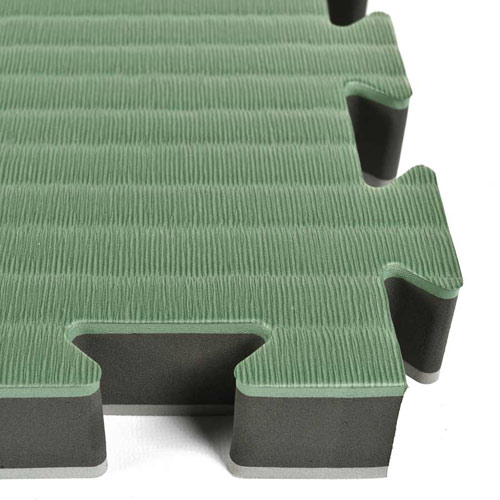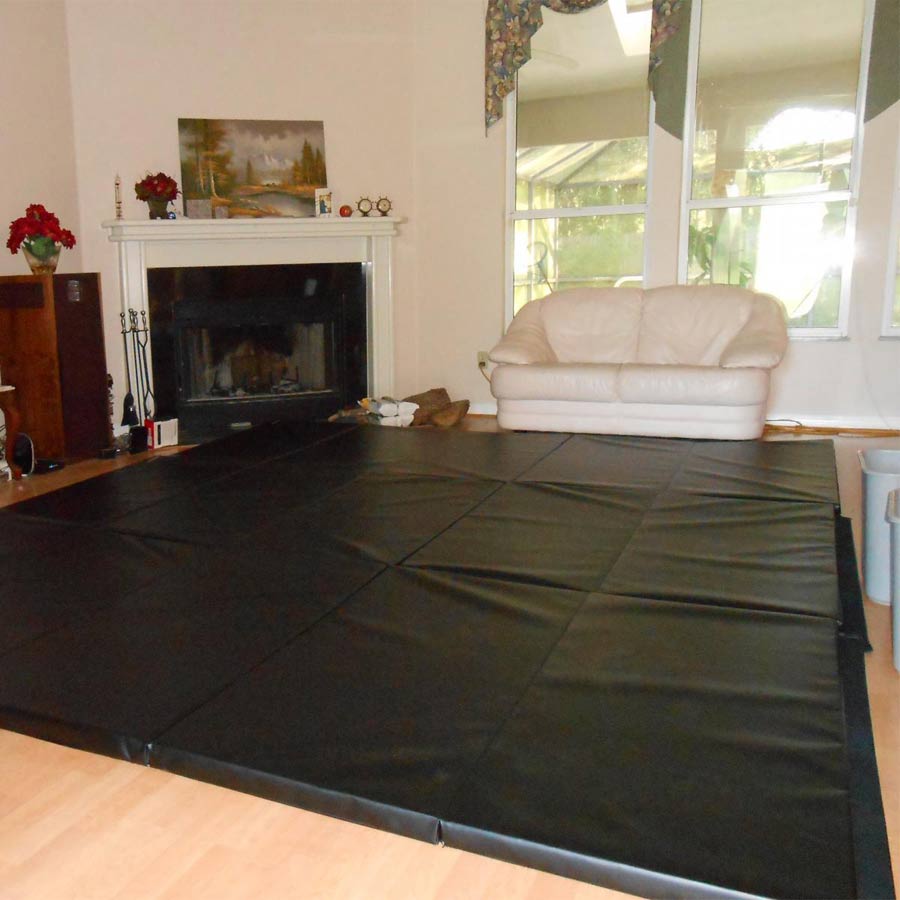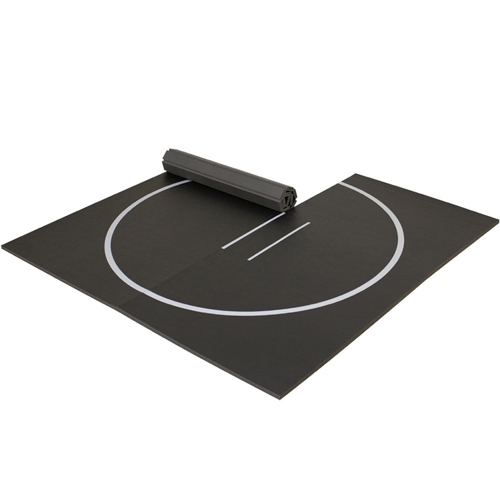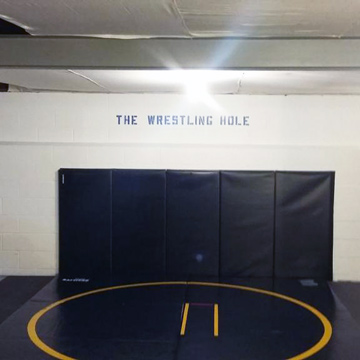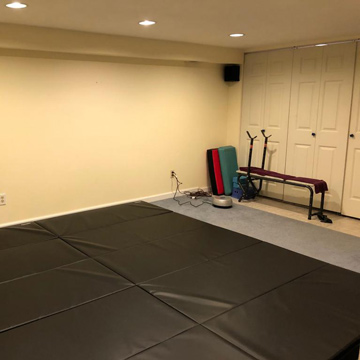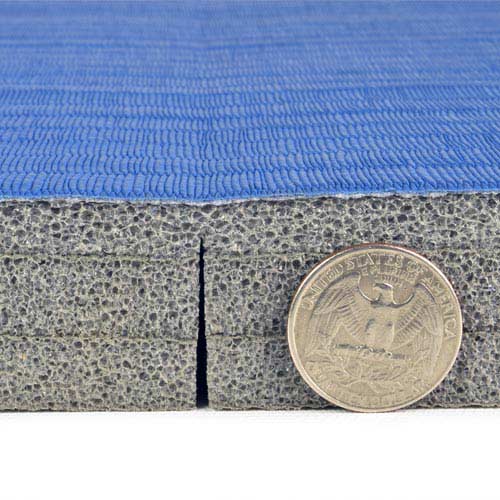Comparing Grappling Mat Materials and Surfaces
Related Product: Grappling MMA Mats 1-1/2 Inch x 1x1 Meter
Core Material
When choosing your grappling mats, the core material is essential, as you will want your flooring to not only provide the appropriate level of cushioning and shock absorption, but also the desired stability and firmness under your feet.The most common commercial core materials are polyvinyl chloride (PVC) nitrile foam, cross-linked polyethylene (PE) foam or ethylene-vinyl acetate (EVA) foam, all of which are closed cell foams which are durable will not absorb water. These foams are more pricey than open cell foams like carpet padding, but will last much longer without absorbing moisture and harboring mold and mildew. There are, however, high end grappling mats that use polyurethane foam, which is a open cell foam known for providing some of the best cushion available. This style of foam, must be contained by a durable cover material.
Typically, grappling mats are available in between 1-2 inch thicknesses. If you plan to do a lot of throwing, thicker mats provide better shock absorption than thin mats as a general rule. Some grappling mats, such as Greatmats Grappling MMA Mats 1-5/8 Inch, are even tested for fall heights and will give you an American Society for Testing and Materials (ASTM) fall height rating.
PVC nitrile foams are the traditional material used for competition wrestling mats. They are the heaviest and most durable option of commercial mat and also the most expensive. This material is flexible enough to be double sided and still roll up for storage.
Cross-linked PE foam is a newer, less expensive and lightweight alternative to the PVC nitrile foams. This foam is firm in nature and introduces some bounce as well as shock absorption to the mat. This PE material is great for home grappling use. It is typically one-sided and scored on the back, allowing it to be rolled up.
EVA foam is the least expensive option, providing most of the same benefits of the other materials without some of the cosmetic durability. While it does not lose its functional benefits with extended use, the wear and tear will be more visible. These mats usually come in puzzle mat form (interlocking tiles) and can be double sided.
Learn more about the foams used in wrestling and grappling mats.
Surface texture and material
The surface texture of your grappling flooring can make a big difference in how you train and as well as the safety and comfort of your training space. Grappling mats can have foam wrapped or bonded to vinyl or canvas. They can also, in the case of EVA foam mats, have the surface texture molded into the same material as the core. The two most common textures are smooth and tatami.Smooth surfaced mats lend well to use with shoes, but can become slippery when training barefoot. They are also less likely to cause mat burns on your skin than more textured surfaces.
Vinyl tatami or canvas surfaces provide extra grip when training barefoot, and are very durable, but are well known for causing mat burns.
EVA mats with tatami texture molded into the surface, provide the grip needed for barefoot grappling training without the risk of mat burns. Keep in mind this surface will scuff, but it will not affect its performance.
Mat size and repair
The larger the mat you get, the fewer seams you will have to deal with. While nearly all wrestling or grappling mats offer a one year warranty, some are easier to install, repair or replace.Your PVC nitrile based mats usually come in the largest rolls (5+ feet wide and varying lengths), but can be cumbersome to install - especially in a home environment or by a single person. The mats can be factory reconditioned or resurfaced should they become damaged.
Cross-linked PE foam mats are often significantly smaller and more lightweight rolls (in the 5x10 foot range). They are lightweight and easy to install by a single person. Multiple mats usually need to be taped together. Should they become damaged, cross-linked polyethylene foam grappling mats can be repaired with a patch, but can not be reconditioned or resurfaced.
EVA puzzle mats usually come in square tiles 2-4 feet in diameter that can connect together in any direct to achieve the desired floor coverage. They cannot be repaired, but are often double-sided, so they can be flipped. Puzzle tiles are also easily replaced in as small as 4 square foot sections without the need for tearing up the entire grappling floor.
Generally vinyl-wrapped PU foam mats come in a 1x2 meter (~3.3x6.6 feet) size. The durable vinyl is extremely resistant to damage and can be patched if needed. These mats usually cannot be connected together but their weight, combined with grippy non-slip underside do a good job of keeping mats in place and allow for multiple mats to be butted up next to each other to expand your grappling area.
Folding mats with a PE core and vinyl cover are available in a large array of sizes, generally from 4 to 6 feet wide and 8 to 12 feet long. For grappling purposes, you'll want to be sure to find folding mats with hook and loop connectors on all four sides to be able to expand your training space as desired and keep the mats held tightly together.
There is a lot to consider when shopping for grappling mats, but if you keep the above factors in mind, you are sure to find grappling mats that will fit you budgetary, space and performance needs.
